
1. Wiring according to the diagram is the highest principle. First, before wiring, one must carefully read the drawings and fully understand the designer’s intentions, rather than relying on personal so-called rich experience. If any unclear or contradictory points are found, one should immediately contact the designer for confirmation before proceeding with the wiring construction.
2. The wiring sequence should be clear and straightforward, with a simple and verifiable process. In practice, this is rarely achieved; usually, wires are simply connected, and the box is closed.
3. Learn wiring techniques and be adept at using professional tools flexibly. For example:
Q: When making a PLC cabinet, there are many wiring boards and terminals. If not handled properly, there can be looseness and burrs. Should we strip the wire and press it in directly, use pins, or solder?
A: For single-core wires, strip and press directly; for multi-core wires, use cold-pressed terminals. Soldering is not recommended.
Q: When there are many expansion modules for the PLC, how should the common and power terminals be handled? Should they be directly paralleled to the next module through the terminals on each PLC module, or connected to terminals and shorted on the terminal block?
A: In field maintenance, we prefer to distribute the power supply at the terminals and lead them to user points (using wire number tubes or marking the terminals to indicate the destination). This is intuitive and minimizes mutual interference. We do not want to connect multiple wires from one point to another, nor do we want more than two wires connected under one terminal. For power terminal blocks, we prefer using terminals with fuses or those that can disconnect connections between terminals, which is very convenient for troubleshooting short circuits.
01PLC Internal and External Circuits1. External Circuit WiringFigure 1 shows the electrical control circuit for full-voltage starting of a motor, where the control logic is implemented through the AC contactor KM coil, indicator lights HL1, HL2, normally closed contacts of the thermal relay FR, stop button SB2, start button SB1, and normally open auxiliary contacts KM connected by wires.When QS is closed and the start button SB1 is pressed, the coil KM is energized and self-locks, connecting the auxiliary contact KM in the branch of indicator light HL1 and the main contact in the main circuit, causing HL1 to light up and the motor M to start. When the stop button SB2 is pressed, the coil KM is de-energized, HL1 goes out, and M stops.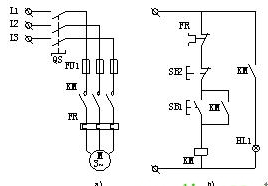 ▲Figure 1 Electrical Control Circuit for Full-Voltage Starting of MotorFigure 2 is the external wiring diagram for full-voltage starting control of a motor using a SIEMENS S7 series PLC. The main circuit remains unchanged, while the normally closed contacts of the thermal relay FR, stop button SB2, start button SB1, etc., are connected to the PLC’s input interface as input devices, and the AC contactor KM coil, indicator lights HL1, HL2, etc., are connected to the PLC’s output interface as output devices. The control logic is implemented through a user program written and stored in the program memory according to the requirements for full-voltage control of the motor.
▲Figure 1 Electrical Control Circuit for Full-Voltage Starting of MotorFigure 2 is the external wiring diagram for full-voltage starting control of a motor using a SIEMENS S7 series PLC. The main circuit remains unchanged, while the normally closed contacts of the thermal relay FR, stop button SB2, start button SB1, etc., are connected to the PLC’s input interface as input devices, and the AC contactor KM coil, indicator lights HL1, HL2, etc., are connected to the PLC’s output interface as output devices. The control logic is implemented through a user program written and stored in the program memory according to the requirements for full-voltage control of the motor.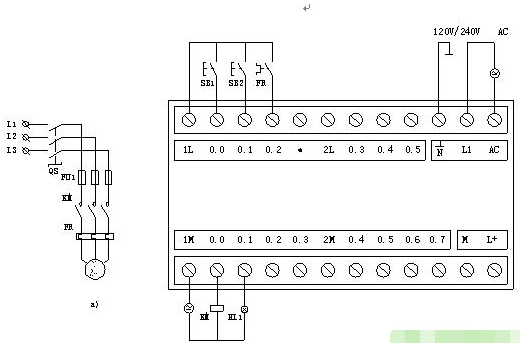 ▲Figure 2 PLC Control Wiring Diagram for Full-Voltage Starting of Motor 2. Establishing the Internal I/O Image AreaIn the PLC memory, an I/O image storage area is allocated to store the status of I/O signals, referred to as input image registers and output image registers. Additionally, other programming elements in the PLC also have corresponding image storage areas, known as element image registers.The size of the I/O image area is determined by the PLC’s system program. For each input point in the system, there is always a corresponding bit in the input image area, and for each output point in the system, there is also a corresponding bit in the output image area. The addressing numbers of the system’s input and output points correspond to the address numbers of the I/O image area.When the PLC operates, the collected input signal status is stored in the corresponding bit of the input image area, and the calculation results are stored in the corresponding bit of the output image area. The data required to describe the equivalent contacts of input relays or the equivalent states of output relays during the execution of the user program is taken from the I/O image area, rather than directly interacting with external devices.The establishment of the I/O image area allows the PLC to only interact with the status data stored in the memory address units during operation, and the system output only sets a status data for a specific memory address unit. This not only speeds up program execution but also isolates the control system from the outside world, enhancing the system’s anti-interference capability.3. Internal Equivalent CircuitFigure 3 shows the internal equivalent circuit of the PLC. Taking the start button SB1 as an example, its input interface I0.0 is connected to a trigger I0.0 in the input image area. When SB1 is activated, the trigger I0.0 is set to a “1” state, and this “1” state can be directly referenced by the user program as the state of the I0.0 contact. At this time, the I0.0 contact has the same state as SB1; if SB1 is activated, the I0.0 contact state is “1”; conversely, if SB1 is deactivated, the I0.0 contact state is “0”.Since the function of the I0.0 trigger is equivalent to that of a relay coil and does not require hard-wired connections, the I0.0 trigger is equivalent to a soft relay coil I0.0 inside the PLC. Directly referencing the state of the I0.0 coil makes the I0.0 contact equivalent to a normally open contact controlled by the I0.0 coil (also known as a dynamic make contact).
▲Figure 2 PLC Control Wiring Diagram for Full-Voltage Starting of Motor 2. Establishing the Internal I/O Image AreaIn the PLC memory, an I/O image storage area is allocated to store the status of I/O signals, referred to as input image registers and output image registers. Additionally, other programming elements in the PLC also have corresponding image storage areas, known as element image registers.The size of the I/O image area is determined by the PLC’s system program. For each input point in the system, there is always a corresponding bit in the input image area, and for each output point in the system, there is also a corresponding bit in the output image area. The addressing numbers of the system’s input and output points correspond to the address numbers of the I/O image area.When the PLC operates, the collected input signal status is stored in the corresponding bit of the input image area, and the calculation results are stored in the corresponding bit of the output image area. The data required to describe the equivalent contacts of input relays or the equivalent states of output relays during the execution of the user program is taken from the I/O image area, rather than directly interacting with external devices.The establishment of the I/O image area allows the PLC to only interact with the status data stored in the memory address units during operation, and the system output only sets a status data for a specific memory address unit. This not only speeds up program execution but also isolates the control system from the outside world, enhancing the system’s anti-interference capability.3. Internal Equivalent CircuitFigure 3 shows the internal equivalent circuit of the PLC. Taking the start button SB1 as an example, its input interface I0.0 is connected to a trigger I0.0 in the input image area. When SB1 is activated, the trigger I0.0 is set to a “1” state, and this “1” state can be directly referenced by the user program as the state of the I0.0 contact. At this time, the I0.0 contact has the same state as SB1; if SB1 is activated, the I0.0 contact state is “1”; conversely, if SB1 is deactivated, the I0.0 contact state is “0”.Since the function of the I0.0 trigger is equivalent to that of a relay coil and does not require hard-wired connections, the I0.0 trigger is equivalent to a soft relay coil I0.0 inside the PLC. Directly referencing the state of the I0.0 coil makes the I0.0 contact equivalent to a normally open contact controlled by the I0.0 coil (also known as a dynamic make contact).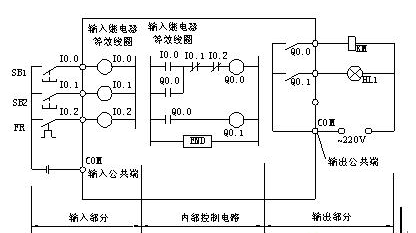 ▲Figure 3 PLC Internal Equivalent CircuitSimilarly, the stop button SB2 is connected to a soft relay coil I0.1 inside the PLC. When SB2 is closed, the state of the I0.1 coil is “1”; conversely, it is “0”. The state of the relay coil I0.1 is inverted by the user program and referenced as the state of the I0.1 contact, so I0.1 is equivalent to a normally closed contact controlled by the I0.1 coil (also known as a dynamic break contact). The output contacts Q0.0 and Q0.1 are the physical normally open contacts of the PLC internal relays, which, when closed, will energize the corresponding KM coil and indicator light HL1. The PLC output terminal has a common interface COM for the output power.02PLC Control SystemUsing a PLC to implement the electrical control system for full-voltage starting of a motor, the main circuit remains essentially unchanged, while the PLC replaces the electrical control circuit.1. Composition of the PLC Control SystemFigure 4 is a basic composition diagram of the PLC control system for full-voltage starting of a motor, which can be divided into three parts: input circuit, internal control circuit, and output circuit.
▲Figure 3 PLC Internal Equivalent CircuitSimilarly, the stop button SB2 is connected to a soft relay coil I0.1 inside the PLC. When SB2 is closed, the state of the I0.1 coil is “1”; conversely, it is “0”. The state of the relay coil I0.1 is inverted by the user program and referenced as the state of the I0.1 contact, so I0.1 is equivalent to a normally closed contact controlled by the I0.1 coil (also known as a dynamic break contact). The output contacts Q0.0 and Q0.1 are the physical normally open contacts of the PLC internal relays, which, when closed, will energize the corresponding KM coil and indicator light HL1. The PLC output terminal has a common interface COM for the output power.02PLC Control SystemUsing a PLC to implement the electrical control system for full-voltage starting of a motor, the main circuit remains essentially unchanged, while the PLC replaces the electrical control circuit.1. Composition of the PLC Control SystemFigure 4 is a basic composition diagram of the PLC control system for full-voltage starting of a motor, which can be divided into three parts: input circuit, internal control circuit, and output circuit.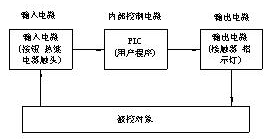 ▲Figure 4 Basic Composition Diagram of PLC Control SystemInput CircuitThe function of the input circuit is to send input control signals to the PLC. The input devices are buttons SB1, SB2, and the normally closed contact FR. The external input control signals are input into the PLC through a corresponding input relay, which can provide any number of normally open and normally closed contacts for programming use in the PLC internal control circuit.Output CircuitThe function of the output circuit is to convert the PLC’s output control signals into signals capable of driving the KM coil and indicator light HL1. The internal control circuit of the PLC contains many output relays. Each output relay, in addition to providing normally open and normally closed contacts for programming use in the PLC internal control circuit, also provides a normally open contact connected to the output port, known as an internal hard contact, which is a physical normally open contact. This contact drives external loads such as the KM coil and HL1 indicator light, while the KM coil controls the starting and stopping of the motor M through the main circuit’s KM main contacts. The power supply for driving the load is provided by an external power source, and the PLC output port also has a common terminal COM for output power.Internal Control CircuitThe internal control circuit is formed by the user program written according to the actual control requirements of the motor. Its function is to calculate, process, and judge the status of input and output signals according to the logical relationships specified in the user program, and then obtain the corresponding output control signals to drive output devices: motor M, indicator light HL1, etc.The user program is input into the PLC’s user program memory through communication with a personal computer or a programmer. Modifications to the user program only require changing certain statements in the memory through devices like programmers, without altering the internal wiring of the controller, achieving flexibility in control.2. PLC Control Ladder DiagramThe ladder diagram is a representation that equivalently models the PLC as a control circuit composed of many internal relay coils, normally open contacts, normally closed contacts, or functional program blocks. Figure 5 shows the commonly used symbols for equivalent control elements in PLC ladder diagrams.
▲Figure 4 Basic Composition Diagram of PLC Control SystemInput CircuitThe function of the input circuit is to send input control signals to the PLC. The input devices are buttons SB1, SB2, and the normally closed contact FR. The external input control signals are input into the PLC through a corresponding input relay, which can provide any number of normally open and normally closed contacts for programming use in the PLC internal control circuit.Output CircuitThe function of the output circuit is to convert the PLC’s output control signals into signals capable of driving the KM coil and indicator light HL1. The internal control circuit of the PLC contains many output relays. Each output relay, in addition to providing normally open and normally closed contacts for programming use in the PLC internal control circuit, also provides a normally open contact connected to the output port, known as an internal hard contact, which is a physical normally open contact. This contact drives external loads such as the KM coil and HL1 indicator light, while the KM coil controls the starting and stopping of the motor M through the main circuit’s KM main contacts. The power supply for driving the load is provided by an external power source, and the PLC output port also has a common terminal COM for output power.Internal Control CircuitThe internal control circuit is formed by the user program written according to the actual control requirements of the motor. Its function is to calculate, process, and judge the status of input and output signals according to the logical relationships specified in the user program, and then obtain the corresponding output control signals to drive output devices: motor M, indicator light HL1, etc.The user program is input into the PLC’s user program memory through communication with a personal computer or a programmer. Modifications to the user program only require changing certain statements in the memory through devices like programmers, without altering the internal wiring of the controller, achieving flexibility in control.2. PLC Control Ladder DiagramThe ladder diagram is a representation that equivalently models the PLC as a control circuit composed of many internal relay coils, normally open contacts, normally closed contacts, or functional program blocks. Figure 5 shows the commonly used symbols for equivalent control elements in PLC ladder diagrams. ▲Figure 5 Commonly Used Symbols for Equivalent Control Elements in Ladder Diagramsa) Coil b) Normally Open Contact c) Normally Closed ContactFigure 6 is the PLC control ladder diagram for full-voltage starting of the motor, composed of the normally closed contact FR, normally closed button SB2, normally open auxiliary contact KM, and normally open button SB1 in a parallel unit, along with the KM coil. The full-voltage starting control ladder diagram is similar in form to the electrical control circuit diagram but also has many differences from it.
▲Figure 5 Commonly Used Symbols for Equivalent Control Elements in Ladder Diagramsa) Coil b) Normally Open Contact c) Normally Closed ContactFigure 6 is the PLC control ladder diagram for full-voltage starting of the motor, composed of the normally closed contact FR, normally closed button SB2, normally open auxiliary contact KM, and normally open button SB1 in a parallel unit, along with the KM coil. The full-voltage starting control ladder diagram is similar in form to the electrical control circuit diagram but also has many differences from it.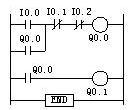 ▲Figure 6 Ladder Diagram for Full-Voltage Starting Control of MotorThe physical structure of relay elements in the ladder diagram differs from that of electrical elements.The coils and contacts in the ladder diagram are functionally equivalent to the coils and contacts of electrical elements. However, in physical terms, the coils and contacts in the ladder diagram are merely storage bits in the input and output memory, differing from the physical structure of electrical elements.The on/off states of relay elements in the ladder diagram differ from those of electrical elements.The on/off states of relay elements in the ladder diagram are related to the data stored in the corresponding storage bits. If the data in that storage bit is “1”, the element is in the “on” state; if the data is “0”, it indicates the “off” state. This differs from the actual on/off states of electrical elements.The state switching process of relay elements in the ladder diagram differs from that of electrical elements.The state switching of relay elements in the ladder diagram is merely an operation on the status data of the storage bits by the PLC. If the PLC assigns the equivalent storage bit data of a normally open contact to “1”, the make operation is completed. Similarly, if the PLC assigns the equivalent storage bit data of a normally closed contact to “0”, the break operation can be completed. The switching operation process has no time delay. In contrast, when electrical element coils and contacts perform make or break switching, there is always a time delay, and generally, the operation must go through a process of first breaking and then closing.The number of contacts belonging to relay elements in the ladder diagram differs from that of electrical elements.If the PLC retrieves a bit data “0” from the corresponding storage bit of the input relay I0.0 and stores it in another storage bit, the stored bit becomes a normally open contact controlled by the I0.0 relay, with the stored data being “0”. If, after retrieving the bit data “0”, an inversion operation is performed before storing it in a storage bit, the stored data will be “1”, and that storage bit will become a normally closed contact controlled by the I0.0 relay.As long as the PLC internal memory is sufficient, this bit data transfer operation can be performed infinitely, and each operation can generate a relay contact in the ladder diagram. Thus, the relay contacts in the ladder diagram can, in principle, be reused infinitely. However, the coils inside the PLC can usually only be referenced once; if the same address number coil needs to be reused, it should be done with caution. In contrast, the number of contacts in electrical elements is limited.The drawing rules for each row in the ladder diagram start from the left bus, passing through contacts and coils (or functional blocks), and ending at the right bus. Generally, parallel units are drawn on the left side of each row, while output coils are drawn on the right side, with other series elements drawn in the middle.Disclaimer:This article is a network reprint, and the copyright belongs to the original author.The articles reproduced do not represent the views of this public account or guarantee their authenticity.However, due to the large number of reproductions, it is impossible to confirm the true original author. If there are any copyright issues, please contact us in a timely manner, and we will delete the content to ensure your rights!
▲Figure 6 Ladder Diagram for Full-Voltage Starting Control of MotorThe physical structure of relay elements in the ladder diagram differs from that of electrical elements.The coils and contacts in the ladder diagram are functionally equivalent to the coils and contacts of electrical elements. However, in physical terms, the coils and contacts in the ladder diagram are merely storage bits in the input and output memory, differing from the physical structure of electrical elements.The on/off states of relay elements in the ladder diagram differ from those of electrical elements.The on/off states of relay elements in the ladder diagram are related to the data stored in the corresponding storage bits. If the data in that storage bit is “1”, the element is in the “on” state; if the data is “0”, it indicates the “off” state. This differs from the actual on/off states of electrical elements.The state switching process of relay elements in the ladder diagram differs from that of electrical elements.The state switching of relay elements in the ladder diagram is merely an operation on the status data of the storage bits by the PLC. If the PLC assigns the equivalent storage bit data of a normally open contact to “1”, the make operation is completed. Similarly, if the PLC assigns the equivalent storage bit data of a normally closed contact to “0”, the break operation can be completed. The switching operation process has no time delay. In contrast, when electrical element coils and contacts perform make or break switching, there is always a time delay, and generally, the operation must go through a process of first breaking and then closing.The number of contacts belonging to relay elements in the ladder diagram differs from that of electrical elements.If the PLC retrieves a bit data “0” from the corresponding storage bit of the input relay I0.0 and stores it in another storage bit, the stored bit becomes a normally open contact controlled by the I0.0 relay, with the stored data being “0”. If, after retrieving the bit data “0”, an inversion operation is performed before storing it in a storage bit, the stored data will be “1”, and that storage bit will become a normally closed contact controlled by the I0.0 relay.As long as the PLC internal memory is sufficient, this bit data transfer operation can be performed infinitely, and each operation can generate a relay contact in the ladder diagram. Thus, the relay contacts in the ladder diagram can, in principle, be reused infinitely. However, the coils inside the PLC can usually only be referenced once; if the same address number coil needs to be reused, it should be done with caution. In contrast, the number of contacts in electrical elements is limited.The drawing rules for each row in the ladder diagram start from the left bus, passing through contacts and coils (or functional blocks), and ending at the right bus. Generally, parallel units are drawn on the left side of each row, while output coils are drawn on the right side, with other series elements drawn in the middle.Disclaimer:This article is a network reprint, and the copyright belongs to the original author.The articles reproduced do not represent the views of this public account or guarantee their authenticity.However, due to the large number of reproductions, it is impossible to confirm the true original author. If there are any copyright issues, please contact us in a timely manner, and we will delete the content to ensure your rights!
If you like it, please give it a thumbs up and take a look